In two groups we show the participants (they should take notes) how to make coffee body scrub using grounded coffee waste, olive oil and sugar. They can use it by themselves or as gifts for others. The students get the task to bring a used and washed jar (for example after a jam) from home to reuse it as a container for the body scrub made during the workshop.
We ask the participants what advantages of making their own cosmetics there are. The ones to mention:
- reusing waste,
- satisfaction,
- health benefits (they know what there is in their handmade cosmetics, it’s natural),
- economical (you don’t spend money on new products),
- reducing waste (by not buying new products – its containers, packaging).


